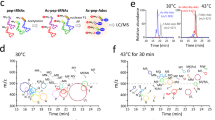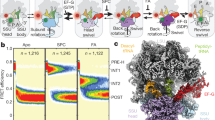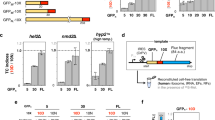Abstract
The overall fidelity of protein synthesis has been thought to rely on the combined accuracy of two basic processes: the aminoacylation of transfer RNAs with their cognate amino acid by the aminoacyl-tRNA synthetases, and the selection of cognate aminoacyl-tRNAs by the ribosome in cooperation with the GTPase elongation factor EF-Tu. These two processes, which together ensure the specific acceptance of a correctly charged cognate tRNA into the aminoacyl (A) site, operate before peptide bond formation. Here we report the identification of an additional mechanism that contributes to high fidelity protein synthesis after peptidyl transfer, using a well-defined in vitro bacterial translation system. In this retrospective quality control step, the incorporation of an amino acid from a non-cognate tRNA into the growing polypeptide chain leads to a general loss of specificity in the A site of the ribosome, and thus to a propagation of errors that results in abortive termination of protein synthesis.
This is a preview of subscription content, access via your institution
Access options
Subscribe to this journal
Receive 51 print issues and online access
$199.00 per year
only $3.90 per issue
Buy this article
- Purchase on Springer Link
- Instant access to full article PDF
Prices may be subject to local taxes which are calculated during checkout





Similar content being viewed by others
References
Edelmann, P. & Gallant, J. Mistranslation in E. coli . Cell 10, 131–137 (1977)
Bouadloun, F., Donner, D. & Kurland, C. G. Codon-specific missense errors in vivo . EMBO J. 2, 1351–1356 (1983)
Gromadski, K. B. & Rodnina, M. V. Kinetic determinants of high-fidelity tRNA discrimination on the ribosome. Mol. Cell 13, 191–200 (2004)
Guth, E. C. & Francklyn, C. S. Kinetic discrimination of tRNA identity by the conserved motif 2 loop of a class II aminoacyl-tRNA synthetase. Mol. Cell 25, 531–542 (2007)
Schmidt, E. & Schimmel, P. Mutational isolation of a sieve for editing in a transfer RNA synthetase. Science 264, 265–267 (1994)
Hopfield, J. J. Kinetic proofreading: a new mechanism for reducing errors in biosynthetic processes requiring high specificity. Proc. Natl Acad. Sci. USA 71, 4135–4139 (1974)
Ninio, J. Kinetic amplification of enzyme discrimination. Biochimie 57, 587–595 (1975)
Soll, D. The accuracy of aminoacylation—ensuring the fidelity of the genetic code. Experientia 46, 1089–1096 (1990)
Szaflarski, W. et al. New features of the ribosome and ribosomal inhibitors: non-enzymatic recycling, misreading and back-translocation. J. Mol. Biol. 380, 193–205 (2008)
Jelenc, P. C. & Kurland, C. G. Nucleoside triphosphate regeneration decreases the frequency of translation errors. Proc. Natl Acad. Sci. USA 76, 3174–3178 (1979)
Brutlag, D. & Kornberg, A. Enzymatic synthesis of deoxyribonucleic acid. 36. A proofreading function for the 3′ leads to 5′ exonuclease activity in deoxyribonucleic acid polymerases. J. Biol. Chem. 247, 241–248 (1972)
Precup, J. & Parker, J. Missense misreading of asparagine codons as a function of codon identity and context. J. Biol. Chem. 262, 11351–11355 (1987)
Brunelle, J. L., Shaw, J. J., Youngman, E. M. & Green, R. Peptide release on the ribosome depends critically on the 2' OH of the peptidyl-tRNA substrate. RNA 14, 1526–1531 (2008)
Youngman, E. M., He, S. L., Nikstad, L. J. & Green, R. Stop codon recognition by release factors induces structural rearrangement of the ribosomal decoding center that is productive for peptide release. Mol. Cell 28, 533–543 (2007)
Dincbas-Renqvist, V. et al. A post-translational modification in the GGQ motif of RF2 from Escherichia coli stimulates termination of translation. EMBO J. 19, 6900–6907 (2000)
Freistroffer, D. V., Kwiatkowski, M., Buckingham, R. H. & Ehrenberg, M. The accuracy of codon recognition by polypeptide release factors. Proc. Natl Acad. Sci. USA 97, 2046–2051 (2000)
Baranov, P. V., Gesteland, R. F. & Atkins, J. F. Recoding: translational bifurcations in gene expression. Gene 286, 187–201 (2002)
Hartz, D., McPheeters, D. S., Traut, R. & Gold, L. Extension inhibition analysis of translation initiation complexes. Methods Enzymol. 164, 419–425 (1988)
Brown, C. M., McCaughan, K. K. & Tate, W. P. Two regions of the Escherichia coli 16S ribosomal RNA are important for decoding stop signals in polypeptide chain termination. Nucleic Acids Res. 21, 2109–2115 (1993)
Katunin, V. I., Muth, G. W., Strobel, S. A., Wintermeyer, W. & Rodnina, M. V. Important contribution to catalysis of peptide bond formation by a single ionizing group within the ribosome. Mol. Cell 10, 339–346 (2002)
Youngman, E. M., Brunelle, J. L., Kochaniak, A. B. & Green, R. The active site of the ribosome is composed of two layers of conserved nucleotides with distinct roles in peptide bond formation and peptide release. Cell 117, 589–599 (2004)
Freistroffer, D. V., Pavlov, M. Y., MacDougall, J., Buckingham, R. H. & Ehrenberg, M. Release factor RF3 in E. coli accelerates the dissociation of release factors RF1 and RF2 from the ribosome in a GTP-dependent manner. EMBO J. 16, 4126–4133 (1997)
Marquez, V., Wilson, D. N., Tate, W. P., Triana-Alonso, F. & Nierhaus, K. H. Maintaining the ribosomal reading frame: the influence of the E site during translational regulation of release factor 2. Cell 118, 45–55 (2004)
Geigenmuller, U. & Nierhaus, K. H. Significance of the third tRNA binding site, the E site, on E. coli ribosomes for the accuracy of translation: an occupied E site prevents the binding of non-cognate aminoacyl-tRNA to the A site. EMBO J. 9, 4527–4533 (1990)
Sundararajan, A., Michaud, W. A., Qian, Q., Stahl, G. & Farabaugh, P. J. Near-cognate peptidyl-tRNAs promote +1 programmed translational frameshifting in yeast. Mol. Cell 4, 1005–1015 (1999)
Dong, H., Nilsson, L. & Kurland, C. G. Co-variation of tRNA abundance and codon usage in Escherichia coli at different growth rates. J. Mol. Biol. 260, 649–663 (1996)
Manley, J. L. Synthesis and degradation of termination and premature-termination fragments of β-galactosidase in vitro and in vivo . J. Mol. Biol. 125, 407–432 (1978)
Dong, H. & Kurland, C. G. Ribosome mutants with altered accuracy translate with reduced processivity. J. Mol. Biol. 248, 551–561 (1995)
Craigen, W. J. & Caskey, C. T. Expression of peptide chain release factor 2 requires high-efficiency frameshift. Nature 322, 273–275 (1986)
Jorgensen, F., Adamski, F. M., Tate, W. P. & Kurland, C. G. Release factor-dependent false stops are infrequent in Escherichia coli . J. Mol. Biol. 230, 41–50 (1993)
Pape, T., Wintermeyer, W. & Rodnina, M. Induced fit in initial selection and proofreading of aminoacyl-tRNA on the ribosome. EMBO J. 18, 3800–3807 (1999)
Bartetzko, A. & Nierhaus, K. H. Mg2+/NH4+/polyamine system for polyuridine-dependent polyphenylalanine synthesis with near in vivo characteristics. Methods Enzymol. 164, 650–658 (1988)
Shaw, J. J. & Green, R. Two distinct components of release factor function uncovered by nucleophile partitioning analysis. Mol. Cell 28, 458–467 (2007)
Brunelle, J. L., Youngman, E. M., Sharma, D. & Green, R. The interaction between C75 of tRNA and the A loop of the ribosome stimulates peptidyl transferase activity. RNA 12, 33–39 (2006)
Shimizu, Y. et al. Cell-free translation reconstituted with purified components. Nature Biotechnol. 19, 751–755 (2001)
Blanchard, S. C., Kim, H. D., Gonzalez, R. L., Puglisi, J. D. & Chu, S. tRNA dynamics on the ribosome during translation. Proc. Natl Acad. Sci. USA 101, 12893–12898 (2004)
Zaher, H. S. & Unrau, P. J. T7 RNA polymerase mediates fast promoter-independent extension of unstable nucleic acid complexes. Biochemistry 43, 7873–7880 (2004)
Moazed, D. & Noller, H. F. Sites of interaction of the CCA end of peptidyl-tRNA with 23S rRNA. Proc. Natl Acad. Sci. USA 88, 3725–3728 (1991)
Dorner, S., Brunelle, J. L., Sharma, D. & Green, R. The hybrid state of tRNA binding is an authentic translation elongation intermediate. Nature Struct. Mol. Biol. 13, 234–241 (2006)
Acknowledgements
We thank B. Cormack, A. Nahvi, A. Buskirk and R. Reed for helpful comments on the manuscript and members of the laboratory for useful discussions. This work was supported by the National Institutes of Health with salary support from Howard Hughes Medical Institute.
Author Contributions H.S.Z. and R.G. designed the experiments and wrote the manuscript. H.S.Z. performed the experiments.
Author information
Authors and Affiliations
Corresponding author
Supplementary information
Supplementary Information
This file contains Supplementary Notes and Supplementary Figures 1-15 with Legends (PDF 2135 kb)
Rights and permissions
About this article
Cite this article
Zaher, H., Green, R. Quality control by the ribosome following peptide bond formation. Nature 457, 161–166 (2009). https://doi.org/10.1038/nature07582
Received:
Accepted:
Published:
Issue Date:
DOI: https://doi.org/10.1038/nature07582
This article is cited by
-
Quality control of protein synthesis in the early elongation stage
Nature Communications (2023)
-
The modular biochemical reaction network structure of cellular translation
npj Systems Biology and Applications (2023)
-
Multi-omics analysis identifies FoxO1 as a regulator of macrophage function through metabolic reprogramming
Cell Death & Disease (2020)
-
Roadblocks and resolutions in eukaryotic translation
Nature Reviews Molecular Cell Biology (2018)
-
Conformation of methylated GGQ in the Peptidyl Transferase Center during Translation Termination
Scientific Reports (2018)
Comments
By submitting a comment you agree to abide by our Terms and Community Guidelines. If you find something abusive or that does not comply with our terms or guidelines please flag it as inappropriate.



